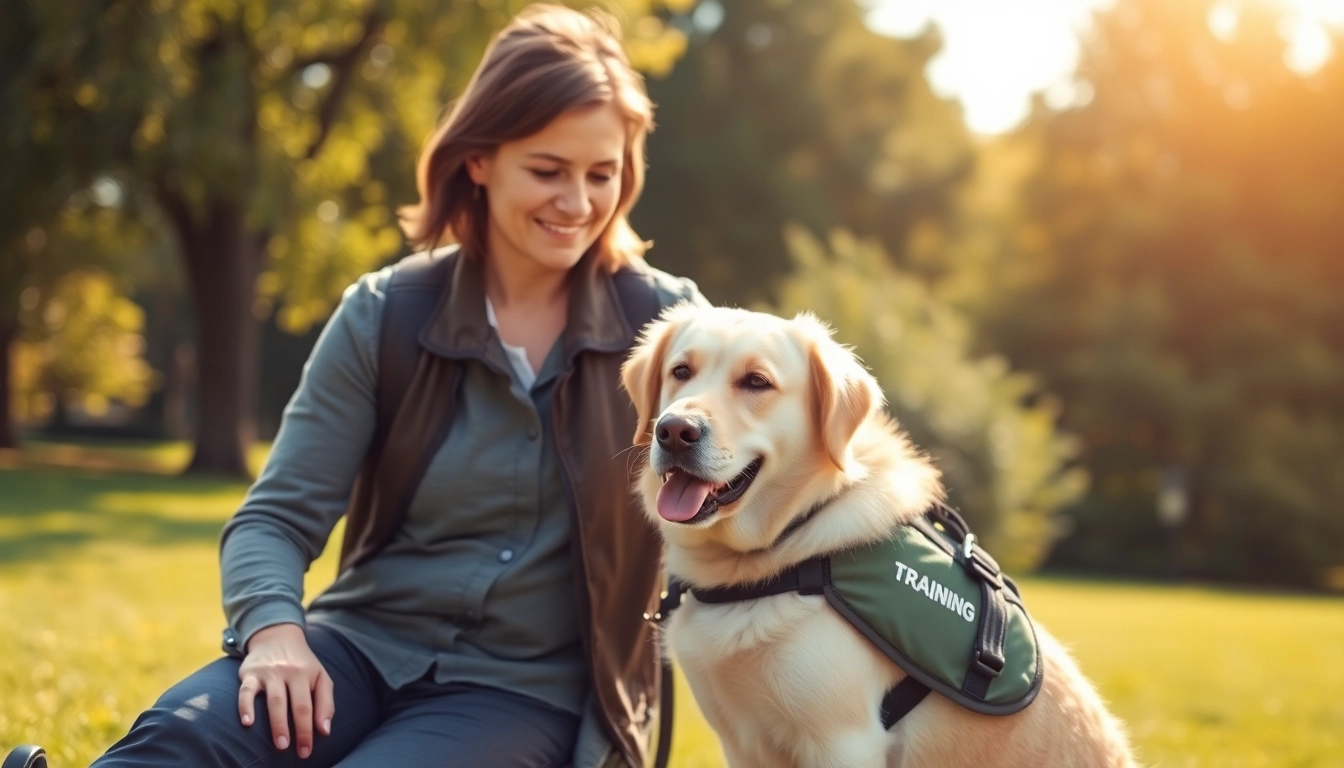Understanding Service Dogs
What is a service dog?
A service dog is a specially trained canine that assists individuals with disabilities in performing tasks that alleviate their challenges. These tasks can vary widely, depending on the person’s needs and the dog’s training. Service dogs are not just pets; they are working animals who are integrated into their handler’s life to enhance their ability to function independently. The primary role of a service dog is to help people with disabilities live more comfortable, productive lives.
Types of service dogs and their roles
Service dogs can be classified into different categories based on the needs they address. Common types include:
- Guide Dogs: These dogs assist individuals who are visually impaired, helping them navigate their surroundings safely.
- Hearing Dogs: Trained to alert individuals who are deaf or hard of hearing to important sounds such as alarms, doorbells, or crying babies.
- Mobility Assistance Dogs: These dogs help individuals with physical disabilities, offering support for balance and stability, retrieving dropped items, or opening doors.
- Medical Alert Dogs: Trained to detect medical conditions such as seizures or fluctuations in blood sugar and alert their handlers or others in case of emergencies.
- Emotional Support Dogs: While not classified as service dogs under the ADA, these dogs provide comfort and emotional support to individuals with mental health challenges.
Each type of service dog is trained to perform specific tasks that are essential to the well-being and safety of their handlers, making their partnership invaluable.
Legal definition and rights
Under the Americans with Disabilities Act (ADA), service dogs are defined as dogs that are trained to perform specific tasks for individuals with disabilities. Importantly, these tasks must be directly related to the individual’s disability.
Service dogs have many legal protections. For example, they are allowed in public spaces where pets are generally not permitted, including restaurants, hotels, and public transportation. This legal status ensures that individuals who rely on service dogs can maintain their independence and access necessary services without barriers.
How to Get a Service Dog
Evaluating your need for a service dog
Before embarking on the journey to get a service dog, it’s essential to evaluate your specific needs. Start by considering the following questions:
- What specific tasks do I need help with that a service dog could assist me with?
- Do I have a diagnosed disability that necessitates a service dog?
- Have I sought advice from healthcare professionals regarding the potential benefits of having a service dog?
Your responses will help clarify whether a service dog is a suitable choice for your situation. Consulting with healthcare providers can also provide insights into the types of training or support you may require.
Steps to get a service dog
The process to get a service dog typically involves several steps:
- Consult with a healthcare professional: Obtain documentation of your disability and discuss the potential role of a service dog in your life.
- Research and identify your needs: Consider what tasks you need assistance with and the type of service dog that could fulfill those needs.
- Find a reputable organization: Look for organizations that are accredited and recognized for their transparency and high training standards.
- Apply for a service dog: Complete the application process with the chosen organization, providing necessary documentation and details about your needs.
- Complete the training: Engage in training with your service dog to ensure that both you and the dog are accustomed to working together effectively.
Finding reputable organizations
Choosing the right organization to help you get a service dog is crucial. Look for the following criteria to identify reputable organizations:
- Accreditation: Check if the organization is accredited by a recognized body like Assistance Dogs International (ADI).
- Transparency: A good organization should be open about its training methods, costs, and success rates.
- Success stories: Read testimonials and success stories from previous clients to gauge the effectiveness of the organization.
- Support services: Ensure that they offer ongoing support and training resources after placement.
Organizations that meet these criteria are more likely to provide quality service dogs that meet your needs.
Costs and Funding Options
Understanding the financial aspect of getting a service dog
Getting a service dog can be a significant financial investment. The costs associated with obtaining a service dog can range from a few thousand to tens of thousands of dollars, depending on the organization and the training provided. Factors such as the type of service dog, training duration, and ongoing care should also be considered.
Common expenses associated with getting a service dog include:
- Initial placement fees
- Training fees for the dog and handler
- Routine veterinary care, vaccinations, and pet insurance
- Equipment, such as harnesses and leashes
Understanding these costs upfront helps in planning your budget accordingly.
Programs that offer financial assistance
Recognizing that the costs can be daunting, various programs may provide financial assistance. These may include:
- Grants from nonprofit organizations dedicated to assisting those with disabilities.
- State and local assistance programs that offer funding for service dogs.
- Veteran services for eligible veterans seeking service dogs.
- Fundraising through local community events or online crowdfunding platforms.
Researching and applying for these programs can substantially alleviate the financial burden of acquiring a service dog.
Fundraising ideas to cover expenses
If costs are prohibitive, consider implementing creative fundraising efforts to cover expenses associated with getting a service dog. Ideas might include:
- Hosting community events such as bake sales, car washes, or garage sales.
- Creating online crowdfunding campaigns to share your story and solicit donations.
- Forming partnerships with local businesses that may sponsor your training costs or contribute resources.
- Seeking sponsorship from organizations and companies in your community.
With planning and outreach, many individuals have successfully raised necessary funds to obtain their service dogs.
Training Your Service Dog
Basic training requirements for service dogs
Service dogs require extensive training to perform their designated tasks. Basic training typically includes:
- Basic obedience commands such as sit, stay, come, and heel.
- Specific task training tailored to the handler’s needs.
- Socialization training to ensure the dog can behave appropriately in various environments.
- Public access training, helping the dog to handle distractions in public settings.
Ongoing training is essential to reinforce these behaviors and ensure the dog adapts to new situations and environments.
Finding a qualified trainer
Finding a qualified trainer or training program is vital for effective service dog training. Consider evaluating trainers based on:
- Experience with service dogs and a demonstrated understanding of disabilities.
- Positive reinforcement training methods that are humane and effective.
- Reviews or recommendations from previous clients who have successfully trained their service dogs.
- Certification from recognized organizations that specialize in service dog training.
The right trainer can make a significant impact on your partnership with your service dog.
Training resources and support
Many resources are available for training service dogs. Consider exploring:
- Local workshops or classes focused on service dog training.
- Online training programs that offer videos and step-by-step guides.
- Books and instructional manuals authored by experienced trainers.
- Support groups and forums where you can connect with other service dog handlers for tips and encouragement.
Leveraging these resources can help you more effectively train your service dog and build a strong partnership.
Maintaining the Bond with Your Service Dog
Building a successful partnership
Building a successful partnership with your service dog requires ongoing effort and commitment. Important strategies include:
- Regular training sessions: Continue training to reinforce commands and behaviors, helping to maintain a strong working relationship.
- Positive reinforcement: Reward your dog for good behavior, strengthening their desire to work with you.
- Social engagement: Spend quality time together outside of work settings, enhancing your bond.
By investing time in training and relationship-building, you and your service dog can effectively work as a cohesive team.
Health and wellness tips
Maintaining your service dog’s health is crucial for ensuring they can perform their duties effectively. Key health and wellness tips include:
- Regular veterinary check-ups and vaccination updates.
- A nutritious diet appropriate to their size, age, and activity level.
- Regular exercise to maintain physical fitness and mental stimulation.
- Routine grooming and hygiene practices.
Keeping your service dog healthy not only benefits their performance but enhances their quality of life.
Community resources for support
Community resources can provide invaluable support for service dog handlers. These may include:
- Local support groups for service dog handlers, providing a network for sharing experiences and resources.
- Online forums and social media groups where you can connect with others nationally or globally.
- Workshops or seminars hosted by local organizations that focus on service dog topics.
Engaging with community resources can help you feel less isolated in your journey and provide additional support for you and your service dog.



